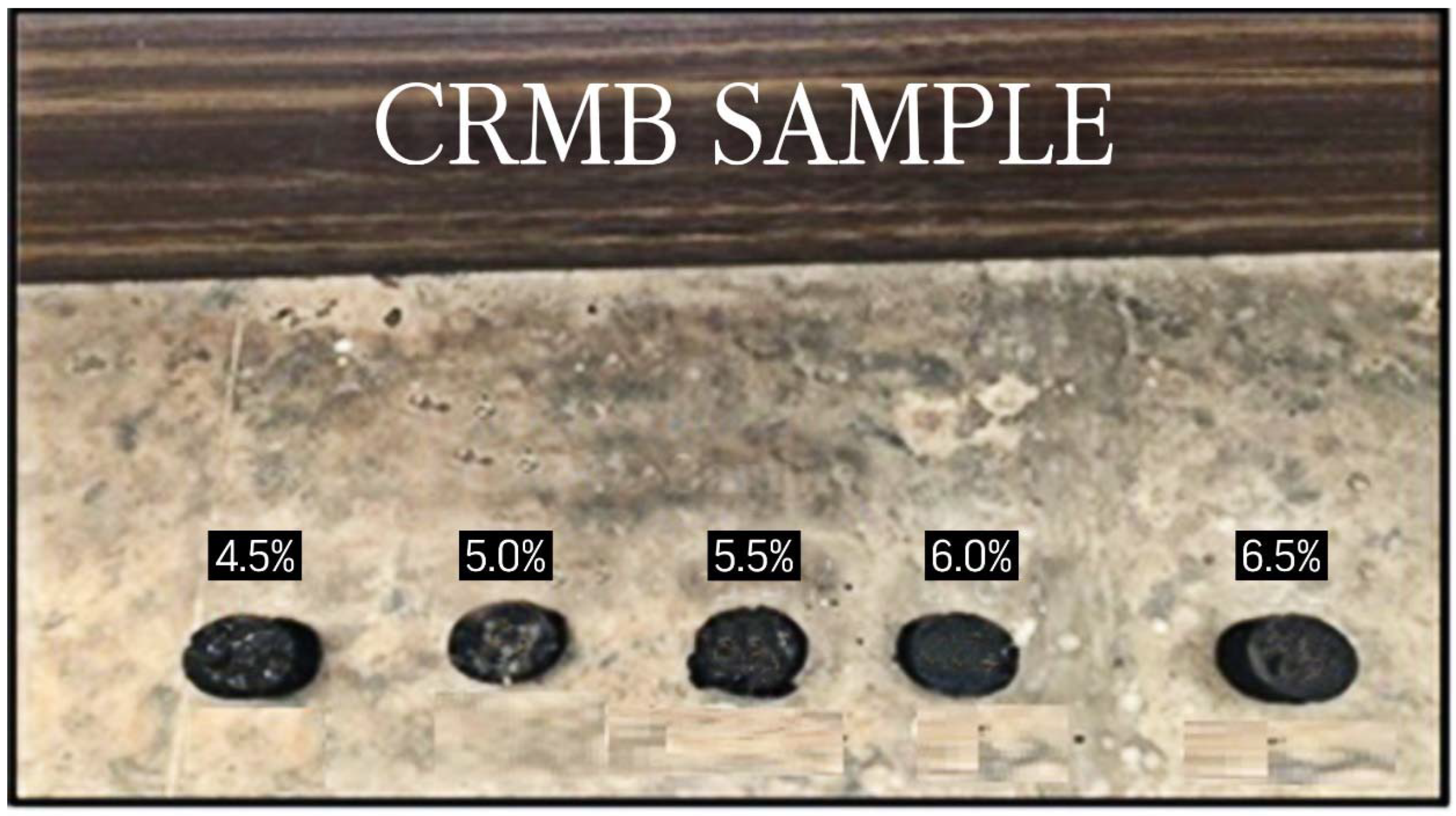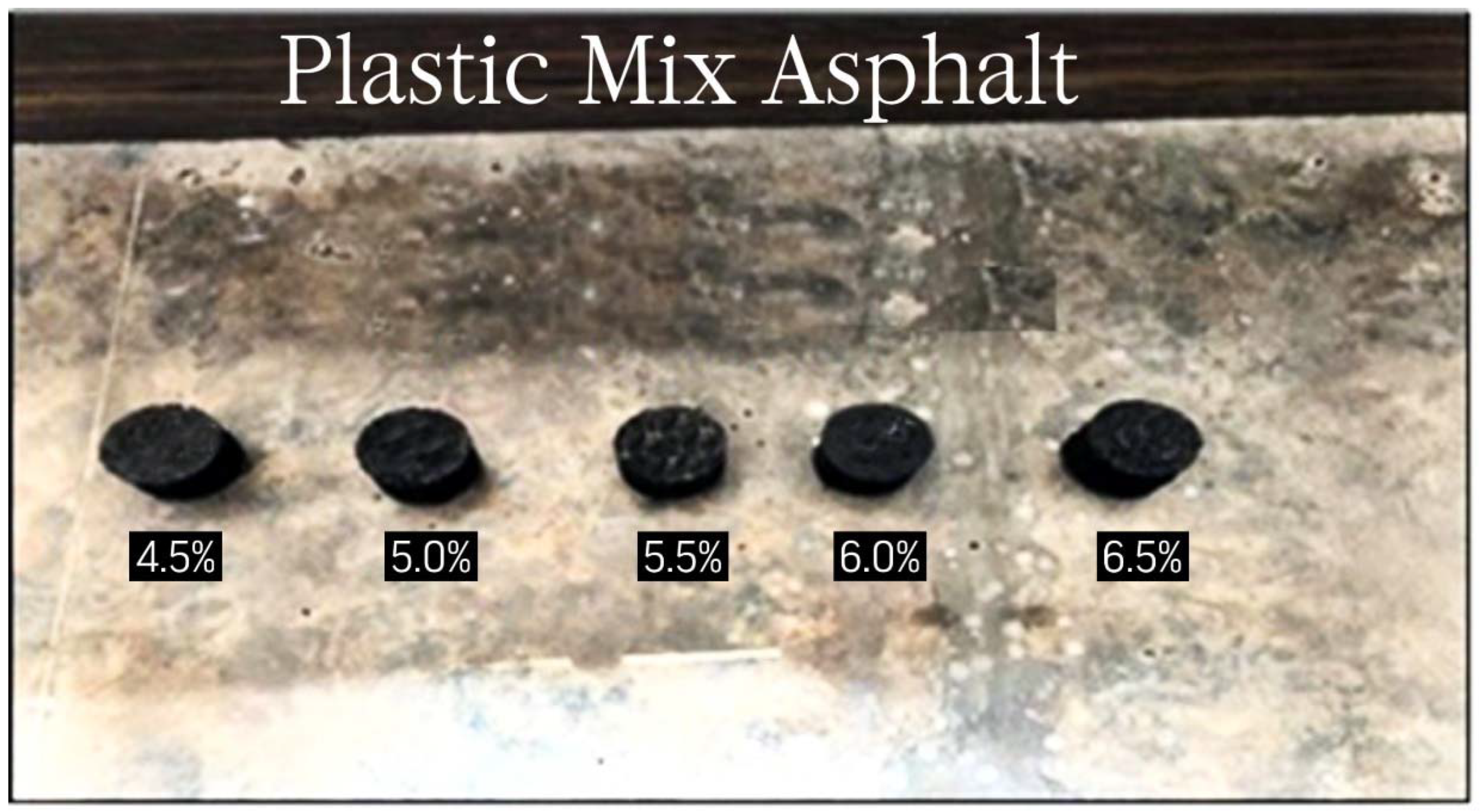Impact of Crumb Rubber Concentration and Plastic Coated Aggregates on the Rheological Performance of Modified Bitumen Asphalt
Abstract
:1. Introduction
2. Materials and Methods
2.1. Marshall Test of Mix Design
2.2. Implemented Steps and Procedures for Experiment
- Test for determination of bulk density.
- Test to check stability and flow.
- Test for analyzing the density and voids of the sample
2.3. Preparation of Specimen for Testing
3. Result and Discussion
3.1. Standard Bitumen Calculation
3.2. Crumb Rubber Modified Bitumen Calculation
3.3. Plastic Mix Asphalt Calculation
4. Conclusions
Author Contributions
Funding
Institutional Review Board Statement
Informed Consent Statement
Data Availability Statement
Acknowledgments
Conflicts of Interest
References
- Association of State Highway and Transportation Officials (AASHTO). Standard Specifications for Transportation Materials and Methods of Sampling and Testing; AASHTO: Washington, DC, USA, 1993. [Google Scholar]
- American Society for Testing and Materials. Annual Book of ASTM Standards Section 4; ASTM-D1559-; American Society for Testing and Materials: Philadelphia, PA, USA, 2002. [Google Scholar]
- Shen, J.; Li, B.; Xie, Z. Interaction between crumb rubber modifier (CRM) and asphalt binder in dry process. Constr. Build. Mater. 2017, 149, 202–206. [Google Scholar] [CrossRef]
- Voskuilen, J.L.M. Causes of premature ravelling failure in porous asphalt. In Proceedings of the 6th RILEM Symposium PTEBM’03, Zurich, Switzerland, 14–16 April 2003; pp. 191–197. [Google Scholar]
- Nimisha, P.R.; Muhammed Shahid, P.T.; Krishna Priya, K.U.; Mohammed, M.; Jobbi, R. Experimental studies on the properties of modified bituminous mixes using crumb rubber. Int. Res. J. Eng. Technol. 2018, 5, 8. [Google Scholar]
- Dantas Neto, S.A. Evaluation of the Properties of Binders and Mixes Modified with Crumb Rubber from Used Tires. Ph.D. Thesis, University of Brasilia, Brasilia, Brazil, 2004. (In Portuguese). [Google Scholar]
- Takallou, H.B.; Takallou, M.B. Effects of mixing time and temperature on the visco-elastic properties of asphalt rubber binder. Asph. Rubber 2003, 12, 589–602. [Google Scholar]
- Anderson, J.; Pampulim, V.; Saim RSousa, J.B. Asphalt rubber laboratory properties related to type and process technology of crumb rubber. In Proceedings of the Asphalt-Rubber Congress, Lisbon, Portugal, 17–19 July 2000. [Google Scholar]
- Bieliatynskyi, A.; Yang, S.; Pershakov, V.; Shao, M.; Ta, M. The use of fiber made from fly ash from power plants in China in road and airfield construction. Constr. Build. Mater. 2022, 323, 126537. [Google Scholar] [CrossRef]
- Raju, Y.K.; Kumar, N.H. Strength Performance of Crumb Rubber Concrete. Int. J. Res. Appl. Sci. Eng. Technol. 2019, 7, 2007–2010. [Google Scholar] [CrossRef]
- Vasudevan, R. A technique to dispose waste plastics in an ecofriendly way—Application in construction of flexible pavements. Constr. Build. Mater. 2012, 28, 311–320. [Google Scholar] [CrossRef]
- Punith, V.S.; Veeraragavan, A. Behavior of Asphalt Concrete Mixtures with Reclaimed Polyethylene as Additive. J. Mater. Civ. Eng. 2007, 19, 500–507. [Google Scholar] [CrossRef]
- Al-Hadidy, A.; Yi-Qiu, T. Effect of polyethylene on life of flexible pavements. Constr. Build. Mater. 2009, 23, 1456–1464. [Google Scholar] [CrossRef]
- Makovetskaya-Abramova, O.; Iwanow, A.; Lazarev, Y.; Szachowa, M.; Rozov, A. Economic assessment of consruction of the roadside service facilities. EDP Sci. 2020, 157, 04035. [Google Scholar]
- McQuillen, J.L.; Takallou, H.B.; Hicks, R.G.; Esch, D. Economic analysis of rubber-modified asphalt mixes. J. Transp. Eng. 1988, 114, 259–277. [Google Scholar] [CrossRef]
- Ali, A.H.; Mashaan, N.S.; Karim, M.R. Investigations of Physical and Rheological Properties of Aged Rubberised Bitumen. Adv. Mater. Sci. Eng. 2013, 2013, 239036. [Google Scholar] [CrossRef] [Green Version]
- Peralta, J.; Silva, H.; Machado, A.; Pais, J.; Pereira, P.; Sousa, J.B. Changes in Rubber Due to its Interaction with Bitumen when Producing Asphalt Rubber. Road Mater. Pavement Des. 2010, 11, 1009–1031. [Google Scholar] [CrossRef]
- Vonk, W.C.; Bull, A.L. Phase phenomena and concentration effects in blends of bitumen and cariflex TR. In Proceedings of the 7th International Roofing Congress, Munich, Germany, 12–14 June 1989. [Google Scholar]
- Sun, D.Q.; Li, L.H. Factors Affecting the Viscosity of Crumb Rubber–Modified Asphalt. Pet. Sci. Technol. 2010, 28, 1555–1566. [Google Scholar] [CrossRef]
- IS 1203:1978; Bitumen and Bituminous Binders. Determination of Needle Penetration. Indian Standards Institution: New Delhi, India, 1978.
- IS 1205-1978; Bitumen and Bituminous Binders. Determination of Softening Point. Ring and Ball Method. Indian Standards Institution: New Delhi, India, 1978.
- IS 1208-1978; Determination of Ductility of Bitumen Water Bath Method. Indian Standards Institution: New Delhi, India, 1978.
- IS 1202-1978; Specific Gravity Test. Indian Standards Institution: New Delhi, India, 1978.
- IS 1206-1978; Determination of Viscosity of Bitumen Using Viscometer. Indian Standards Institution: New Delhi, India, 1978.
- IS 1209-1978; Determination of Flash and Fire Point Using Pensky-Martens Flash Point Apparatus. Indian Standards Institution: New Delhi, India, 1978.
- Brown, E.R.; Kandhal, P.S.; Zhang, J. Performance testing for hot mix asphalt. In NCAT Report 01-05; 277 Technology Parkway Auburn University: Auburn, AL, USA, 2001. [Google Scholar]
- Al-Busaltan, S.; Al Nageim, H.; Atherton, W.; Sharples, G. Green Bituminous Asphalt relevant for highway and airfield pavement. Constr. Build. Mater. 2012, 31, 243–250. [Google Scholar] [CrossRef]
- Singh, V.; Bawa, A. Experimental study on partial replacement of bitumen with crumb rubber. SSRG Int. J. Civ. Eng.-Spec. 2017, 9–14. [Google Scholar]




| S.NO | Particulars | Avg. | Standard Deviation |
|---|---|---|---|
| 1 | Specific gravity (G) fine aggregate | 2.67 | 0.13 |
| 2 | Specific gravity (G) coarse aggregate | 2.69 | 0.05 |
| 3 | Aggregate impact value | 25.06 | 0.63 |
| 4 | Percentage of wear (abrasion value) | 33.2 | 0.16 |
| 5 | Specific gravity (standard) | 1.039 | 0.00 |
| 6 | Specific gravity (CRMB) | 1.02 | 0.01 |
| 7 | Viscosity in seconds (standard) | 4′58″ | 0.04 |
| 8 | Viscosity in seconds (CRMB) | 4′35″ | 0.02 |
| 9 | Softening point of bitumen (standard) | 52.5 °C | 1.00 |
| 10 | Softening point of bitumen (CRMB) | 66.5 °C | 0.50 |
| 11 | Flashpoint of bitumen (standard) | 305 °C | - |
| 12 | Fire point of bitumen (standard) | 310 °C | - |
| 13 | Flashpoint of bitumen (CRMB) | 249 °C | - |
| 14 | Fire point of bitumen (CRMB) | 256 °C | - |
| 15 | Ductility (standard) | 100 | 0.00 |
| 16 | Ductility (CRMB) | 80.33 | 1.25 |
| 16 | Penetration value (standard) (0.1 mm) | 55.66 | 3.86 |
| 17 | Penetration value (CRMB) (0.1 mm) | 24.33 | 0.47 |
| Bitumen Content (%) | Void Mineral Aggregate | % Air Voids | Stability (N) | Flow (mm) | Unit Wt. (gm/cm3) |
|---|---|---|---|---|---|
| 4.5 | 13.87 | 9.82 | 3534 | 0.33 | 2.31 |
| 5 | 13.646 | 9.1 | 4371 | 0.42 | 2.328 |
| 5.5 | 13.75 | 8.726 | 5096.4 | 0.54 | 2.338 |
| 6 | 13.85 | 8.35 | 6240 | 0.67 | 2.372 |
| 6.5 | 13.99 | 8.01 | 5338.2 | 0.88 | 2.345 |
| Bitumen Content (%) | Unit Wt. (gm/cm3) | Void Mineral Aggregate | % Air Voids | Corr. Stability (N) | Flow (mm) |
|---|---|---|---|---|---|
| 4.5 | 2.2 | 14.71 | 10.67 | 3268 | 2.2 |
| 5 | 2.17 | 14.81 | 10.33 | 4730 | 2.7 |
| 5.5 | 2.28 | 14.92 | 9.96 | 7031 | 3.05 |
| 6 | 2.54 | 15.17 | 9.77 | 6510.4 | 3.32 |
| 6.5 | 2.32 | 15.28 | 9.4 | 5108.6 | 3.42 |
| Bitumen Content (%) | Unit Wt. (gm/cm3) | Void Mineral Aggregate | % Air Voids | Corr. Stability (N) | Flow (mm) |
|---|---|---|---|---|---|
| 4.5 | 2.065 | 19.52 | 15.73 | 9500 | 0.66 |
| 5 | 2.072 | 18.28 | 13.98 | 11,856 | 0.87 |
| 5.5 | 2.08 | 18.41 | 13.67 | 9424 | 1.1 |
| 6 | 2.198 | 18.56 | 13.37 | 9165.6 | 1.25 |
| 6.5 | 2.095 | 18.69 | 13.03 | 6232 | 1.43 |
Publisher’s Note: MDPI stays neutral with regard to jurisdictional claims in published maps and institutional affiliations. |
© 2022 by the authors. Licensee MDPI, Basel, Switzerland. This article is an open access article distributed under the terms and conditions of the Creative Commons Attribution (CC BY) license (https://creativecommons.org/licenses/by/4.0/).
Share and Cite
Kumar, A.; Berwal, P.; Al-Mansour, A.I.; Khan, M.A.; Alam, S.; Lee, S.M.; Malik, A.; Iqbal, A. Impact of Crumb Rubber Concentration and Plastic Coated Aggregates on the Rheological Performance of Modified Bitumen Asphalt. Sustainability 2022, 14, 3907. https://doi.org/10.3390/su14073907
Kumar A, Berwal P, Al-Mansour AI, Khan MA, Alam S, Lee SM, Malik A, Iqbal A. Impact of Crumb Rubber Concentration and Plastic Coated Aggregates on the Rheological Performance of Modified Bitumen Asphalt. Sustainability. 2022; 14(7):3907. https://doi.org/10.3390/su14073907
Chicago/Turabian StyleKumar, Arun, Parveen Berwal, Abdullah I. Al-Mansour, Mohammad Amir Khan, Shamshad Alam, Seongkwan Mark Lee, Akash Malik, and Amjad Iqbal. 2022. "Impact of Crumb Rubber Concentration and Plastic Coated Aggregates on the Rheological Performance of Modified Bitumen Asphalt" Sustainability 14, no. 7: 3907. https://doi.org/10.3390/su14073907







